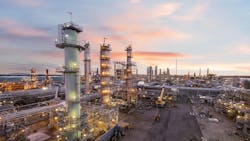bp completes investment projects at Cherry Point refinery
bp PLC has finished a series of earlier proposed investment projects aimed at improving reliability and efficiency, reducing emissions, and expanding renewable diesel production at its 238,450-b/d Cherry Point refinery in Blaine, Wash., near Bellingham.
After a year and a half of work, bp in early June completed works related to installation of the Cherry Point hydrocracker improvement project’s (HIP) new vacuum tower, as well as the site’s separate cooling water infrastructure (CWI) project, Eric Zimpfer, bp Cherry Point’s vice-president of refining, said in a post to his official social media account.
“The new vacuum tower and [CWI] projects will reduce refinery emissions by more than 5%, the annual equivalent of taking 28,000 cars off the road,” Zimpfer said.
The announcement follows bp’s late-2022 completion of a $45-million renewable diesel optimization (RDO) project that doubled the refinery’s renewable diesel production capacity to 2.6 million bbl/year, bp said in its annual Year in Review report for 2022.
First announced in October 2021, the trio of projects came as part of a nearly $270-million combined investment at Cherry Point to reduce the refinery’s operational carbon dioxide (CO2) emissions by about 7%, from then-existing levels and double the site’s output of renewable diesel, in line with the company’s goals of achieving net zero emissions across its global operations and reducing the carbon intensity of products it sells by 2050 or sooner (OGJ Online, Oct. 4, 2021).
Designed to improve the refinery’s efficiency and reduce periods of planned maintenance to result in fewer unit shutdowns and associated flaring events, the estimated $169-million HIP was designed to enable the hydrocracker to consume less hydrogen—which Cherry Point produces by conversion of natural gas in process that yields CO2 emissions—as well as reduce its current heat input requirement from the consumption of gaseous fuel in refinery process heaters.
Alongside construction of a new process-structure area, motor control building, pipe rack supports, and associated equipment foundations, HIP also was to include installation of a new vacuum tower, as well as relocation and installation of underground utilities within existing operational areas of the refinery, according to a December 2020 project description by Washington state regulators.
The estimated $55-million CWI project was to involve upgrading the refinery’s cooling water infrastructure, allowing for increased utilization, better energy efficiency, and a related reduction in CO2 emissions. Alongside improving reliability by enabling the refinery to maintain a year-round optimum cooling water temperature, increased efficiency of the site’s cooling towers upon the CWI project’s completion was to result in reduced production of light hydrocarbons—such as methane and ethane—combusted in process heaters and utility boilers.
About the Author
Robert Brelsford
Downstream Editor
Robert Brelsford joined Oil & Gas Journal in October 2013 as downstream technology editor after 8 years as a crude oil price and news reporter on spot crude transactions at the US Gulf Coast, West Coast, Canadian, and Latin American markets. He holds a BA (2000) in English from Rice University and an MS (2003) in education and social policy from Northwestern University.

